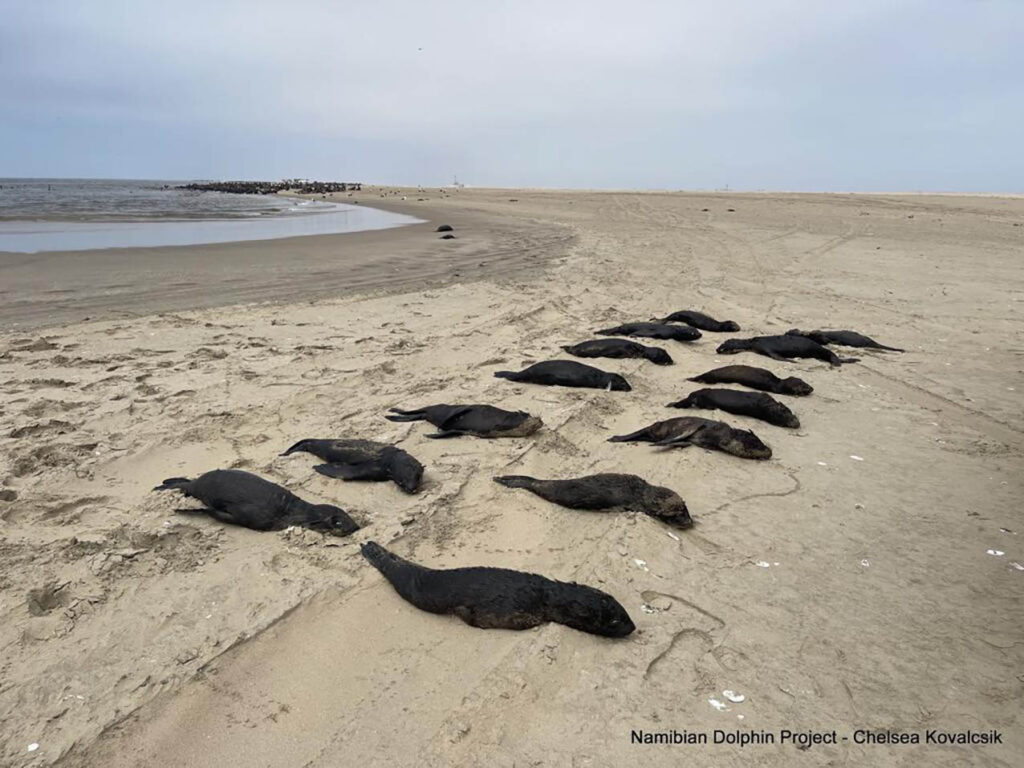Hundreds of Cape fur seals have washed up dead over the past few weeks on a stretch of Namibian coastline in the latest mass die-off of the semi-aquatic mammals.
“It truly feels like a warzone out there,” said Chelsea Kovalcsik, education field officer for the Namibian Dolphin Project. “And I don’t say that lightly because it’s just hundreds upon hundreds of dead seals littering these beaches … It’s been mentally and emotionally taxing.”
The carcasses are mostly washing ashore at Pelican Point, a 5km colony in Walvis Bay. According to Kovalcsik, they are mostly pups and yearlings.
“We don’t have an exact idea of what is causing these mass strandings or mass die-offs but we have our speculations,” the marine biologist said. “In the past couple of weeks, we’ve noticed a bunch of different animals washing out. We’ve had an insane amount of bivalves [molluscs], crabs, eels, fish like mullet and other species. Most noticeably, we’ve had this pretty massive seal die-off.”
Deaths not natural
Namibia is home to the world’s largest colony of Cape fur seals, which have a natural mortality rate of about 40%.
“We’ve noticed way more dead seals washing up on the beaches than we have in the past,” Kovalcsik said. “We are tending to believe that the event we’re witnessing is not natural and is not normal to this scale.”
On February 23 alone, more than 400 carcasses at Pelican Point were recorded. “It just one day kind of started in full force. This has been happening for months now in South Africa,” she said, referring to the thousands of Cape fur seals that have died on the West Coast in recent months.
“The scientists from Sea Search in South Africa have been prepping us and we’ve been prepared that this could potentially move to Namibia but they now have months of research data and field practice that we don’t have just because we haven’t been dealing with an event of this magnitude.”
The pups are largely dependent on their mother’s milk. “They are not thin, did not die of malnutrition, pollution or exposure to noise as they are not swimming deep in the ocean,” according to the Namibian Dolphin Project.

Marine biotoxin
The best guess, according to Tess Gridley, the co-director of Sea Search and an extraordinary lecturer in the department of botany and zoology at Stellenbosch University is that the seals were exposed to a naturally occurring marine biotoxin through their mothers’ milk. Gridley previously told the M&G that she suspects domoic acid, produced by certain types of algae, is a possible culprit for the major seal die-off on the West Coast.
“I think this is all biotoxin linked. They’re pups and they’re not weaned so other causes of death don’t make sense but biotoxin-related deaths due to poisoning effectively in the mother’s milk, that makes sense. We’re not there yet, as we’ve got to do so much more sampling.
“In South Africa, we’re looking at very skinny animals that were slowly showing decreased condition and were very thin. But in Namibia, the pups themselves are fat. I would say that what we’re looking at in Namibia, my best guess is that we’re looking at an acute exposure of a toxin that kills the pups. So, they’re not feeding themselves and must be exposed via their mother’s milk. This is all still hypothetical, though.”
‘Seizing in the water’
The race is now on to collect scientific data. Every day, Kovalcisk and her small team of colleagues cover as much ground as possible at Pelican Point, photographing, measuring and sampling the dead seals.
“We’re noticing them more at the very end on the lagoon side washing up. What we believe to be happening is that they’re dying in the water and then the tide is bringing them on shore. We have noticed a few dying on land,” she said, explaining how local kayak guides have reported the seals “seizing in the water and dying in the water”.
The seal deaths don’t seem to be slowing down. “Two weeks ago, it seems as though there was one big die-off event. Since that event, we haven’t had a single event exactly like that … However, I wouldn’t say it’s necessarily waned because every day we go out we’re still noting freshly dead animals,” she said, explaining how the fresher the carcass, the better the chances of detecting toxins.

Multiple stressors
“We’re seeing so many older dead seals and newer dead ones piling on them and then you still have these live colonies. It’s quite a stark contrast to see dozens of dead seals literally along with hundreds of living seals. It’s shocking.”
In late 2020, thousands of Cape fur seals died in an “abortion storm” in Namibia. “We’re experiencing something different,” Kovalcisk said. “It could be the same cause, but the age difference is different than it was two years ago.”
Everything is interconnected in the oceans. “You think of climate change as our oceans are warming and all sorts of things that are just multiple stressors on these animals. It could very well be one event and we are considering that but it could also be a mix of multiple events. As scientists and marine biologists, we cannot rule anything out at the moment.”
Kovalcsik told how, last week, a seal pup seized to death in her arms. “It was horrific. It eats away at you a little bit but it also adds fuel to the fire of why we’re really trying to figure this out because it’s important and animals are dying.”
[/membership]